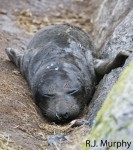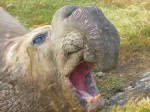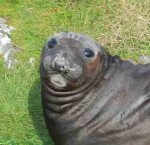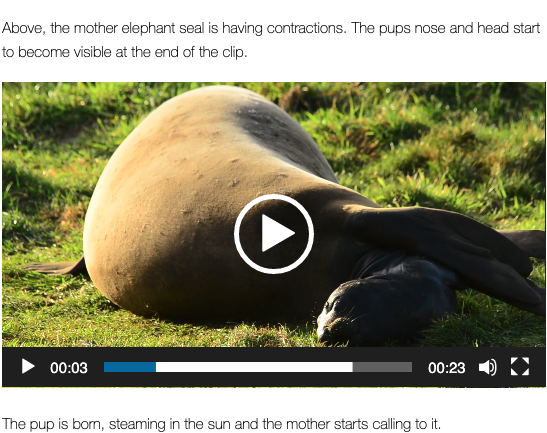The range of this pelagic animal, who spends 80-90% of its time underwater, includes 65 km (35 miles) offshore and has been known to dive to depths of 5000 ft., with an average underwater time of 20 minutes. Migrating further than any animal in the world, they have been known to travel up to 6000 miles.
Very Very Fat…
The elephant seal’s main predators are sharks and orcas, the only marine animals that can bite through it’s many centimeters of subcutaneous fat. Their fat, streamlined bodies are the best diving enabled of all animals, and it keeps them warm, too. Such low metabolism tissue is great for storage of energy and nutrients, especially during their fasts (of up to 3 months, sometimes losing 1,500 lbs.!) during the mating and molting seasons.
How do they get so fat?
From eating eels, skates, rays, squid, octopi, red crabs, pacific hake and small sharks. This carnivorous marine mammal dives to the bottom of the ocean to retrieve its meals. At night, M. angustirostris eats from the depths of the mesopelagic zone, picking on organisms that travel upwards at night. Thus, dives are shallower and it’s easier to see the prey because most fish with such behavior are bioluminescent. Seals swallow their food in large chunks rather than chewing it. While on land, seals are hydrated by their own fat, and at sea they get the liquids they need from their food so they don’t have to drink water
The Life of an Elephant Seal
There are 7 known rookeries in Southern California and Mexico, where these giant marine mammals haul out onto the beaches each December-March to give birth and breed. Race Rocks is the furthest north record for elephant seal births.
The males are the keeners, arriving ashore one month ahead of the females, who birth 6 days after arriving on the beaches. Pups weigh from 30 kg (65 lbs.) and are about 4 feet (1.25 m) in length. Most of this specie’s time is spent lounging on the beach, while males fight for dominance.
The females nurse their pups for 28 days, at which point they suddenly leave and the pup is forced to be weaned after tripling its birth weight. Four days before leaving, the females breed with the dominant males. They are pregnant when they leave, but the embryo does not implant itself for another three months, to ensure that they give birth 6 days after arriving ashore the same time next year.
Finally, the pups are left behind to fend for themselves. They travel in packs called “pods” for the first 12 weeks of their lives, learning to swim in shallow waters before heading to the continental slope to forage for food.
Classification:
Phylum Chordata
Subphylum Vertebrata
Domain Eukarya
Kingdom Animalia
Class Mammalia
Order Carnivora
Suborder Pinnipedia
Family Phocidae
Subfam. Monachinae
Genus Mirounga
species angustirostris
Common Name Northern Elephant seal
M. Angustirostris at Race Rocks
Try these references to learn more about the northern elephant seal in the Ecological reserve.
A Conservation Success
In the 19th century, these beasts were hunted to near extinction. What for? Their fat was used in lamp oil (they can produce 325 L of fine oil). Now, the estimated population of 100 (1910) has grown to estimates of 130,000, with the help of conservationists and protected habitats. These animals are no nuisance to fishermen in B.C., so the only true threat remaining is the destruction of their habitat by tourism and development.
A major problem remaining for these animals is simply their privacy and the ignorance of humans. A few years ago, a juvenile animal hauled ashore to molt on a Metchosin beachnear Victoria, BC. Its sickly appearance worried a passerby who called the SPCA. As a result a decision was made to call in an officer of the local federal fisheries office to destroy the animal. The advice of local residents who yearly saw the moulting process as a natural event was ignored and the animal was shot. It is time for humans to leave these animals alone when they are moulting on local beaches, and not to intervene in ignorance.
General Appearance & TaxonomyAs a member of the Phocid, or true seal, family, M.angustirostris has no external ear flaps and flops on its belly to move around on land. The black coat that pups have at birth is molted at weaning to reveal a silver gray coat, which turns silvery brown in a year’s time. Their broad, round faces are complimented well by very large, round, cow-like eyes. A close cousin of the northern elephant seal is the southern elephant seal, or Mirounga leonina. The northern elephant seal is only two thirds the size of this species, the only other member of its genus. The southern version can be found in the waters of Antarctica, off places such as Argentina and New Zealand.
 This is an excellent video reference on research on Elephant Seals
This is an excellent video reference on research on Elephant Seals









